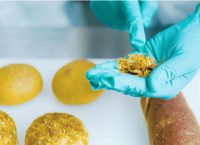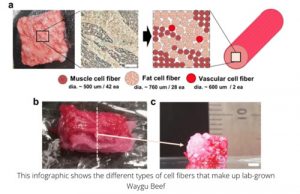As worries over personal health and the health of the environment loom, many consumers have turned to alternative protein as a way to make a healthy swap. Companies such as Beyond Meat and Impossible Foods have popularized alternative protein with their plant-based products. However, as technology continues to improve, new innovations have emerged that have allowed for the exact taste and texture of meat to be replicated. Outlined below are three innovative takes on alternative protein.
Air Protein
 A Finnish tech company by the name of Solar Foods has been working since 2017 to develop Solein, a protein made completely with air. Electricity is added to water in order to release bubbles of CO2 and hydrogen; microbes are then added to the water, and are nourished using the bubbles. The end product is a protein powder that is completely tasteless, yet replicates all of the same amino acids as meat. With a texture similar to flour, Solein can be incorporated into a wide variety of foods, such as pasta, bread, and yogurt. It can also be 3D printed in order to add texture, and can be added to plant-based protein alternatives; it has already been tested with plant-based meatballs and burger patties. Because Solein does not rely on agriculture and is not affected by weather conditions, Solar Foods is saying that Solein is “the world’s most sustainable form of protein” and is 100 times more climate friendly than any other animal protein or plant-based alternative. Solar Foods is currently building their first industrial scale factory to produce Solein, and has hopes to produce enough Solein powder for 2 billion meals by the end of 2022.
A Finnish tech company by the name of Solar Foods has been working since 2017 to develop Solein, a protein made completely with air. Electricity is added to water in order to release bubbles of CO2 and hydrogen; microbes are then added to the water, and are nourished using the bubbles. The end product is a protein powder that is completely tasteless, yet replicates all of the same amino acids as meat. With a texture similar to flour, Solein can be incorporated into a wide variety of foods, such as pasta, bread, and yogurt. It can also be 3D printed in order to add texture, and can be added to plant-based protein alternatives; it has already been tested with plant-based meatballs and burger patties. Because Solein does not rely on agriculture and is not affected by weather conditions, Solar Foods is saying that Solein is “the world’s most sustainable form of protein” and is 100 times more climate friendly than any other animal protein or plant-based alternative. Solar Foods is currently building their first industrial scale factory to produce Solein, and has hopes to produce enough Solein powder for 2 billion meals by the end of 2022.
Cultured Meat
Cultured Meat, also known as lab-grown meat, is created by harvesting muscle cells from living animals, and then nurturing the cells so they create tissue, which can be combined to create a final product. Cultured meat can be made using 99% less space than current livestock farming, making it more sustainable. Currently, the costs of creating cultured meat are expensive; Memphis Meats, a California food technology startup, says it currently costs them roughly $600 to create a cultured meat burger. However, when this technology debuted in 2013, it cost over $300,000. If this trend continues, the cost of cultured meat could become competitive in several years. While not currently available in North America, US startup Just Eats lab grown chicken nuggets have passed safety reviews by the Singapore Food Agency, and are being sold around Singapore. While still slightly more expensive than traditional chicken (a meal using lab-grown chicken costs an average of $17 in Singapore restaurants), it legitimizes the safety of lab-grown meat, giving other companies opportunities to popularize it worldwide.
 3D Printed Protein
3D Printed Protein
3D printing works by laying down thin layers of materials, and fusing them together in order to create a 3D object. While widely used in engineering and architecture spaces, there is a new use emerging for 3D printing technology: protein. Barcelona-based Novameat has set out to create 3D printed pork and steak. Novameat combines layers of vegetable fat with mammal fat cells in order to mimic the structure of muscle components and tissue from real animals. Using 3D printing, they are able to fully customize the cuts of meat they create and make each cut unique, similar to cuts of meat from animals. Their target is not necessarily vegans or vegetarians, but meat lovers.Their goal is to not only create a product that closely resembles traditional meat, but is superior. “Alternative meats shouldn’t just be for the environment or animals or health, they should be superior compared to what they’re trying to compete with.” While Novameat combines animal fat cells with layers of plant protein, other companies are working on lab-grown protein made completely from animal stem cells. In September, scientists from the Osaka University in Japan successfully 3D printed a cut of Wagyu beef, using two different types of stem cells from Wagyu cows. While 3D printed meat is not currently available in North America for consumer consumption, many scientists see it as a viable alternative to livestock for those who want the taste and texture of real meat.
Sources
https://www.greenqueen.com.hk/solar-foods-air-sustainable-protein-factory/
https://www.smithsonianmag.com/smart-news/scientists-create-first-3-d-printed-wagyu-beef-180978565/
https://www.novameat.com/
https://culturedbeef.org/what-cultured-meat
https://www.scientificamerican.com/article/lab-grown-meat/
https://www.dezeen.com/2019/07/03/solein-solar-foods-design/
https://www.solein.com/foods

